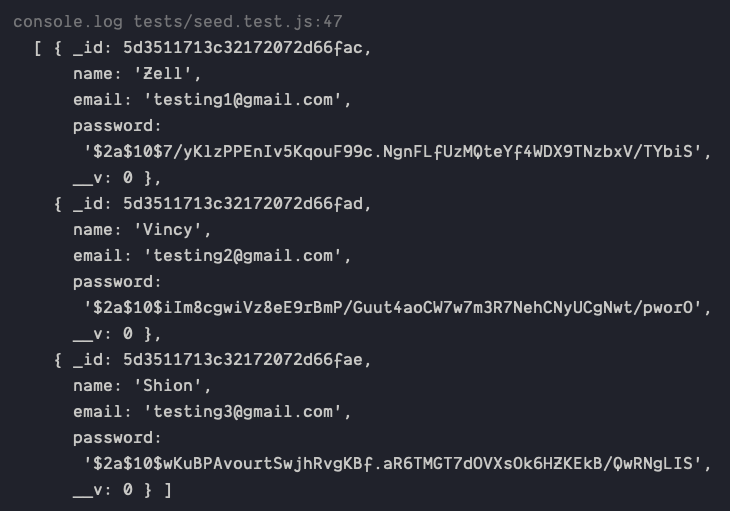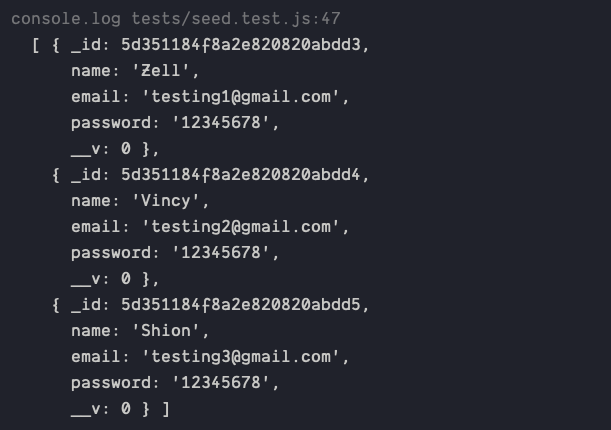This content originally appeared on Zell Liew and was authored by Zell Liew
When you write tests for the backend, you need to test for four different kinds of operations:
- Create (for adding things to the database)
- Read (for getting things from the database)
- Update (for changing the database)
- Delete (for deleting things from the database)
The easiest type to test for is create operations. You put something into the database and test whether it’s there.
For the other three types of operations, you need to put something into the database before you write the test.
Putting things into the database
The process where you add initial content to a database is called seeding.
Let’s say you want to add three users to the database. These users contain a name and an email address.
const users = [{
name: 'Zell',
email: 'testing1@gmail.com'
}, {
name: 'Vincy',
email: 'testing2@gmail.com'
}, {
name: 'Shion',
email: 'testing3@gmail.com'
}]
You can use your models to seed the database at the start of the test.
const User = require('../model/User') // Link to User model
it('does something', async done => {
// Add users to the database
for (const u of users) {
const user = new User(u)
await user.save()
}
// Create the rest of your test here
})
If you need these users for every test, the best way is to add them through the beforeEach hook. The beforeEach hook runs before every it declaration.
// Seed the database with users
beforeEach(async () => {
for (u of users) {
const user = new User(u)
await user.save()
}
})
You can also use Mongoose’s create function to do the same thing. It runs new Model() and save(), so the code below and the one above does the same thing.
// Seed the database with users
beforeEach(async () => {
await User.create(users)
})
create vs insertMany
Mongoose has a second method to help you seed the database. This method is called insertMany. insertMany is faster than create, because:
insertManysends one operation to the servercreatesends one operation for each document
However, insertMany does not run the save middleware.
Is triggering the save middleware important?
This depends on your seed data. If your seed data needs to go through the save middleware, you need to use create. For example, let’s say you want to save a user’s password into the database. You have this data:
const users = [{
name: 'Zell',
email: 'testing1@gmail.com',
password: '12345678'
}, {
name: 'Vincy',
email: 'testing2@gmail.com',
password: '12345678'
}, {
name: 'Shion',
email: 'testing3@gmail.com',
password: '12345678'
}]
When we save a user’s password into the database, we want to hash the password for security reasons. We usually hash the password through the save middleware.
// Hashes password automatically
userSchema.pre('save', async function (next) {
if (!this.isModified('password')) return next()
const salt = bcrypt.genSaltSync(10)
const hashedPassword = bcrypt.hashSync(password, salt)
this.password = hashedPassword
})
If you use create, you’ll get users with hashed passwords:

If you use insertMany, you’ll get users without hashed passwords:

When to use create, when to use insertMany
Since insertMany is faster than create, you want to use insertMany whenever you can.
Here’s how I do it:
- If seed data does not require the
savemiddleware, useinsertMany. - If seed data requires
savemiddleware, usecreate. Then, overwrite seed data so it no longer requires thesavemiddleware.
For the password example above, I would run create first. Then, I copy-paste the hashed password seed data. Then, I’ll run insertMany from this point onwards.
If you want to overwrite complicated seed data, you might want to get JSON straight from MongoDB. To do this, you can use mongoexport:
mongoexport --db <databaseName> --collection <collectionName> --jsonArray --pretty --out output.json
This says:
- Export
<collection>from<databaseName> - Creates output as a JSON Array, prettified, in a file called
output.json. This file will be placed in the folder where you run the command.
Seeding multiple test files and collections
You want a place to store your seed data so you can use them across all your tests and collections. Here’s a system I use:
- I name my seed files according to their models. I seed a
Usermodel with theuser.seed.jsfile. - I put my seed files in the
seedsfolder - I loop through each seed file to seed the database.
To loop through each seed file, you need to use the fs module. fs stands for filesystem.
The easiest way to loop through the files is to create an index.js file in the same seeds folder. Once you have the index.js file, you can use the following code to look for all files with *.seed.js
const fs = require('fs')
const util = require('util')
// fs.readdir is written with callbacks.
// This line converts fs.readdir into a promise
const readDir = util.promisify(fs.readdir)
async function seedDatabase () {
// Gets list of files in the directory
// `__dirname` points to the `seeds/` folder
const dir = await readDir(__dirname)
// Gets a list of files that matches *.seed.js
const seedFiles = dir.filter(f => f.endsWith('.seed.js'))
}
Once you have a list of seed files, you can loop through each seed file to seed the database. Here, I use a for...of loop to keep things simple.
async function seedDatabase () {
for (const file of seedFiles) {
// Seed the database
}
}
To seed the database, we need to find the correct Mongoose model from the name of the seed file. A file called user.seed.js should seed the User model. This means:
- We must find
userfromuser.seed.js - We must capitalize
userintoUser
Here’s a crude version that does what’s required. (If you want to, you can make the code more robust with regex instead of split).
for (const file of seedFiles) {
const fileName = file.split('.seed.js')[0]
const modelName = toTitleCase(fileName)
const model = mongoose.models[modelName]
}
Next, we want to make sure each file has a Model that corresponds to it. If the model cannot be found, we want to throw an error.
for (const file of seedFiles) {
//...
if (!model) throw new Error(`Cannot find Model '${modelName}'`)
}
If there’s a corresponding model, we want to seed the database with the contents in the seed file. To do this, we need to read the seed file first. Here, since I used the .js extension, I can simply require the file.
for (const file of seedFiles) {
//...
const fileContents = require(path.join(__dirname, file))
}
For this to work, my seed files must export an array of data.
module.exports = [{
name: 'Zell',
email: 'testing1@gmail.com',
password: '12345678'
}, {
name: 'Vincy',
email: 'testing2@gmail.com',
password: '12345678'
}, {
name: 'Shion',
email: 'testing3@gmail.com',
password: '12345678'
}]
Once I have the contents of the seed file, I can run create or insertMany.
async function seedDatabase (runSaveMiddleware = false) {
// ...
for (const file of seedFiles) {
// ...
runSaveMiddleware
? model.create(fileContents)
: model.insertMany(fileContents)
}
}
Here’s the whole seedDatabase code:
const fs = require('fs')
const util = require('util')
const readDir = util.promisify(fs.readdir).bind(fs)
const path = require('path')
const mongoose = require('mongoose')
function toTitleCase (str) {
return str.replace(/\w\S*/g, (txt) => {
return txt.charAt(0).toUpperCase() + txt.substr(1).toLowerCase()
})
}
async function seedDatabase (runSaveMiddleware = false) {
const dir = await readDir(__dirname)
const seedFiles = dir.filter(f => f.endsWith('.seed.js'))
for (const file of seedFiles) {
const fileName = file.split('.seed.js')[0]
const modelName = toTitleCase(fileName)
const model = mongoose.models[modelName]
if (!model) throw new Error(`Cannot find Model '${modelName}'`)
const fileContents = require(path.join(__dirname, file))
runSaveMiddleware
? await model.create(fileContents)
: await model.insertMany(fileContents)
}
}
Why JS, not JSON?
It’s the industry norm to use JSON to store data. In this case, I find it easier to use JavaScript objects because:
- I don’t have to write opening and closing double-quotes for each property.
- I don’t have to use double-quotes at all! (It’s easier to write single-quotes because there’s no need to press the shift key).
// Which is easier to write. JavaScript objects or JSON?
// JavaScript objects
module.exports = [{
objectName: 'property'
}]
// JSON
[{
"objectName": "property"
}]
If you want to use JSON, make sure you change seedDatabase to work with JSON. (I’ll let you work through the code yourself).
Adjusting the setupDB function
In the previous article, I created a setupDB function to help set up databases for my tests. seedDatabase goes into the setupDB function since seeding is part of the setting up process.
async function seedDatabase (runSaveMiddleware = false) {
// ...
}
module.exports = {
setupDB (databaseName, runSaveMiddleware = false) {
// Connect to Mongoose
beforeAll(/*...*/)
// Seed Data
beforeEach(async () => {
await seedDatabase(runSaveMiddleware)
})
// Cleans up database between each test
afterEach(/*...*/)
// Disconnect Mongoose
afterAll(/*...*/)
}
}
A Github Repository
I created a Github repository to go with this three-part testing series. I hope this demo code helps you start testing your applications.
This content originally appeared on Zell Liew and was authored by Zell Liew
Zell Liew | Sciencx (2019-08-21T00:00:00+00:00) Seeding a database. Retrieved from https://www.scien.cx/2019/08/21/seeding-a-database/
Please log in to upload a file.
There are no updates yet.
Click the Upload button above to add an update.
